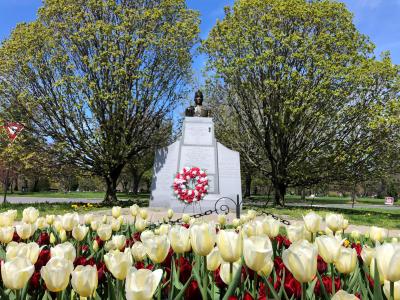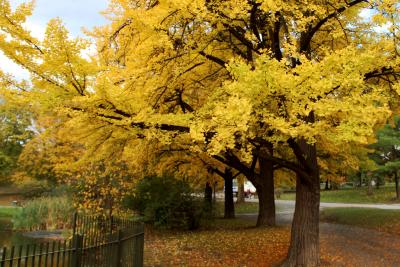
Washington Park is an urban oasis in the heart of the City of Albany. Treasured by locals and visitors alike, Washington Park is a destination during all four seasons. This year marks the 150th anniversary of the historic park! To celebrate, scroll on for 10 fun facts about Washington Park.
Looking to learn more? The Washington Park Conservancy is a volunteer, nonprofit organization that preserves, protects and promotes the historic park. Follow the Conservancy on Facebook for special events, park clean-ups, guided tours, and more information.

1. 89 Acres in Size
Washington Park is about 89 acres in size! It is located within the Washington Park Historic District, a primarily residential neighborhood that is on the National Register of Historic Places. The Washington Park Lake, nestled in the southwestern corner of the park, is 5.2-acres. The park also boasts a playground, a variety of monuments, benches, picnic tables and many winding paths for walking and biking.

2. It is an "Olmstedian" park
Created in the 1870s, Washington Park is an “Olmstedian” park. It incorporates many of the philosophical ideals used by Frederick Law Olmsted when he designed New York City's Central Park. Washington Park's Knox Street Mall, while smaller, is reminiscent of the popular Central Park Mall in NYC!

3. Home to over 100 species of trees
Washington Park is home to over 100 species of trees including bonsai trees and towering oaks. During the spring, many of the trees are flowering with a variety of seasonal blooms. Once the flowers fade into green leaves, escape the summer heat in the shade of the meandering tree-lined paths. During the autumn months, the historic park transforms into a fall foliage paradise with leaf-covered paths and vibrant trees. When winter arrives, the park's snow-covered trees are a picturesque backdrop for snowshoeing or ice skating on the lake.

4. The location of Tulip Festival since 1949
Albany's landmark Tulip Festival has called Washington Park home since 1949. The festival celebrates Albany's Dutch heritage with live music, food, arts vendors, the crowning of the Tulip Queen and her court, and much more. Washington Park is transformed into a sea of over 100,000 blossoming tulips, with the gardens around the King Memorial Fountain as the focal point. The stunning sight, featuring tulips in all colors of the rainbow, is cared for by the City of Albany Department of General Services and the City Gardeners.

Bonus: After the beloved tulips fade, the garden beds are transformed by the City Gardeners into a lush oasis with an assortment of tropical plants. Visit during the summer months to be transported to a tropical paradise in the middle of Albany!

5. The footbridge is the oldest and only remaining original structure
A picturesque stroll through Washington Park is not complete without crossing the charming footbridge over Washington Park Lake. Erected in 1875, the footbridge is the oldest and only original structure still remaining in the park. From 2013 to 2015, the Washington Park Conservancy funded repairs for the bridge for the most comprehensive restoration in its history.

6. The park has 6 monuments
There are 6 monuments sprinkled throughout Washington Park. Visit the Henry Johnson Memorial, erected in 1991, that honors one of Albany's greatest war heroes. Sgt. Henry Johnson was an African American U.S. Army soldier who fought heroically in the 369th Infantry Regiment, called the Harlem Hellfighters, of the U.S. Army in World War I. Johnson was awarded the Medal of Honor by President Barack Obama posthumously in 2015. Another monument celebrates the famous Scottish poet Robert Burns. The bronze statue, standing sixteen feet high, was sculpted by Charles Calverley and erected in 1888. The four panels around the base, installed in 1891, each feature one of Burns' poems. Perhaps the most famed statue in Washington Park is the King Memorial Fountain (often referred to as the Moses Fountain). Surrounded by magnificent tulip beds in the spring, the fountain's focal point is a bronze statue of Moses smiting the rock for water on Mount Horeb. The figures surrounding Moses on the mountain represent the four stages of life: infancy, youth, adulthood and old age. The statue was sculpted by J. Massey Rhind and erected in 1893. The other monuments include the Soldiers and Sailors’ Monument, erected 1912, Dr. James H. Armsby Memorial, erected 1879, and the Marinus Willett Memorial, placed 1907 and relocated 2006.

7. For over 30 years, Playhouse Stage Company has performed outdoor theater in the park
Enjoy theater under the stars each summer! Playhouse Stage Company performs on a stage in front of the Washington Park Lake House surrounded by a 900-seat outdoor amphitheater. It is a favorite summertime tradition in Albany. The 2021 summer season kicks off with Ain’t Misbehavin’ from July 6 to 24, followed by Matilda The Musical from August 5 to 21.

8. It is a top spot for birdwatching
Washington Park is a wonderful place for birdwatching. Dozens of species of birds can be spotted in the park including wood ducks, mallards, Northern cardinals, a Great blue Heron, red-winged blackbirds, yellow warblers and much more. It is a great spot to reconnect with nature and to go scouting for wildlife. Don't forget your binoculars!
Bonus: In the center of a garden bed at Washington Park Road and Hudson Avenue, find a whimsical birdhouse! The intricate wood birdhouses were hand-carved by Albany artist William Schade. Swing by to see if you can spy any birds fluttering among the impressive display of birdhouses.

9. Relax on an "Albany Bench"
After strolling through Washington Park, relax and soak up the scenery on an "Albany Bench." Located on the Knox Street Mall and around the lake, the "Albany Bench" was designed specifically for the City of Albany by sculptor Merlin Szosz. The "Albany Bench" is an ornate cast iron frame with wooden seats and back support. The design was commissioned, purchased, and placed by the Washington Park Conservancy.

10. Among other things, it was once a cemetery!
Before transforming into the picturesque park we know it as today, Washington Park was a cemetery! It was public property and thousands of people were buried on the land. Eventually as downtown Albany became overcrowded, the Albany elite began to move uptown towards this area. It was decided that the land would be better used as park, so over ten thousand bodies were reinterred to Albany Rural Cemetery and other locations. The park has also been used for gunpowder storage.






